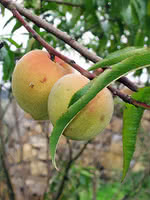Mon-Fri 9am - 5pm Mountain time
Black Locust vs Siberian C Peach
Robinia pseudoacacia
Prunus persica Siberian C
NOT AVAILABLE THIS SEASON - MIGHT RETURN
Black Locust is an attractive tree. Its distinctive leaves are made of about a dozen bright green leaflets. It also notable for its fragrant white flowers, which smell of citrus.
Black Locust can grow in many situations, but prefers dry areas with lots of sun. It is robust and is an excellent choice for establishing shade in dry, open areas.
Important note: Much of the Black Locust is toxic to humans and livestock, including seeds, bark, and leaves.
The Siberian C Peach is a cold hardy peach cultivar, and the fruit is great for producing juice and fresh eating. This variety is native to the Gobi desert area of China, and is relatively true to seed. In colder climates they might not grow fruit reliably as they require a relatively hot summer for the fruit to produce.
Unlike most peach trees the Siberian C Peach doesn’t require thinning and is quite productive. The fruit are firm enough to handle mechanical harvesting.
While it is possible to graft other peach varieties to the Siberian C Peach, research has shown that the Chui Lum Tao Peach and Tzim Pee Tao Peach are better candidates for rootstock.

